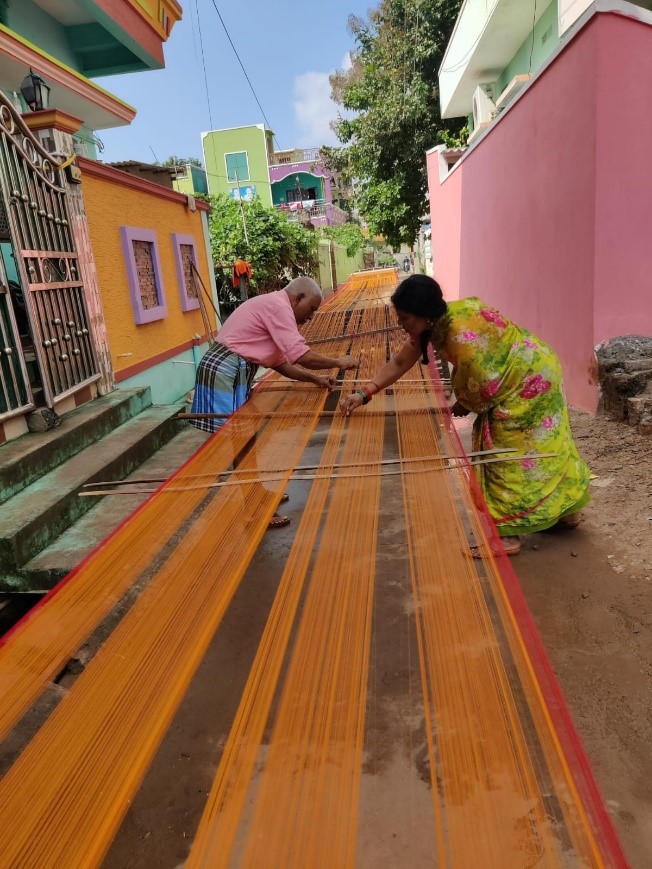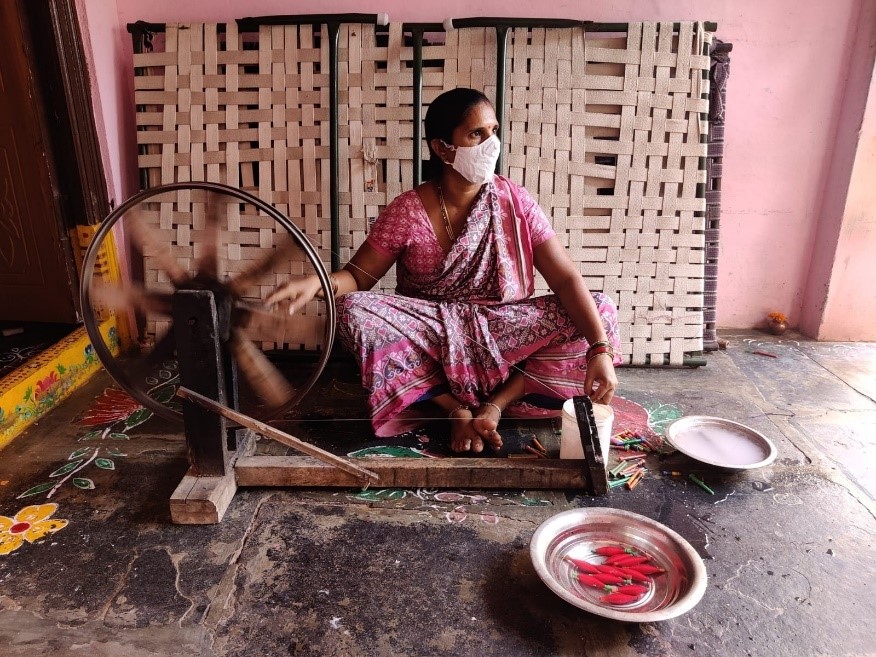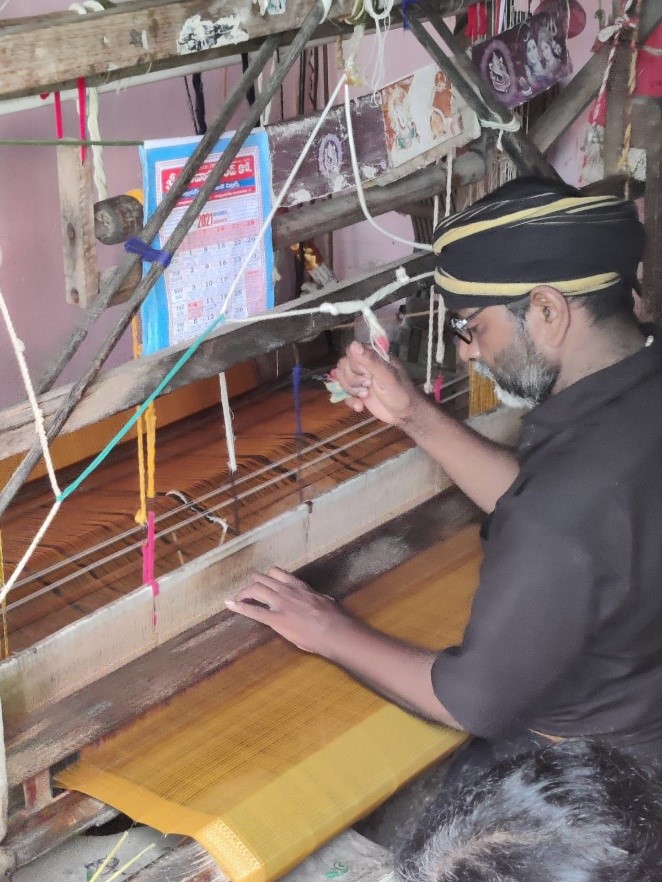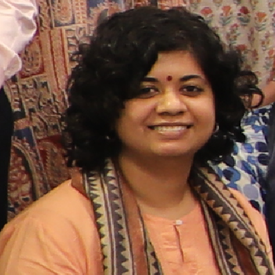The lack of market demand and low earnings, as well as competition from power looms, has led to declining participation of artisans in India's handloom industry. In this note, Dang et al. share some insights gained through conversations with women weavers and other members of the weaving community, which reveal the need for greater technical and management training and provision of suitable working conditions for weavers to ensure the long-term sustainability of weaving enterprises.

A husband and wife setting the loom in Guntur district.
Picture credit: Shreya Banerjee
India’s handloom sector – the country’s second largest employer after agriculture – remains fraught with challenges. Even before the onset of the pandemic, the All-India Handloom Census 2019-20 indicated that lack of market demand, non-availability of credit, and low earnings plagued the working of the sector. These difficulties have now been exacerbated as a consequence of Covid-19.
Women comprise around 73% of India’s total weavers, and as many as 48% of them are based in Andhra Pradesh and Telangana (All-India Handloom Census 2019-20). However, competition from power looms, lack of capital investment and professional skill set, and insufficient income pose challenges to the industry and contribute to the declining participation – the younger generations in particular are increasingly refraining from pursuing this profession. Between 2009-10 and 2019-20, the share of weavers in rural areas in the 18-35 age group fell from 50% to 43%. The declining participation of younger artisans also poses concerns related to the loss of traditional weaving knowledge, which is passed on from one generation to the next.
“It is mostly the older generation that is still weaving these days. Most young people don’t show any interest in weaving – they are taking up other occupations and moving to other towns. We (she and her husband) don’t get enough work. What is the point of them entering this sector?”
– A weaver in East Godavari district.
While many work independently, women weavers in India are largely part of cooperatives, producer companies or work with master weavers1. We worked with women weavers who are part of the producer companies facilitated by Chitrika Foundation in two states. Since its formation in 2006, Chitrika has been an incubator of handloom and artisan enterprises. It mobilises and capacitates women weavers into producer companies. It is also one of the first organisations to facilitate the formation of an all-women weaver producer company in Andhra Pradesh. Our collaboration with Chitrika and discussions with women weavers brought out lessons that can help make weaving a viable and sustainable enterprise and prove to be a shot in the arm for this sector.
Interventions to strengthen capacities of women weavers
In both Andhra Pradesh and Telangana, close to 50% of weavers work with master weaves, and only some weavers are part of cooperatives or producer companies (All-India Handloom Census, 2019-2020). Master weavers are skilled artisans with an entrepreneurial mode of operation – they typically employ labour and sometimes provide raw material to produce weaving outputs that are either sold directly in the market, to other master weavers, or traders. On the other hand, cooperatives and producer companies allow marginalised producers to come together in an organised manner and move up the value chain with assured business ownership (Venkatkumar and Sontakki 2012). Weavers that are part of cooperatives of producer companies are usually shareholders and are sometimes exposed to different parts of the weaving value chain – including marketing and management, whereas weavers working under master weavers are primarily wage workers.
Our work shows that while working with master weavers offers flexibility of work, which is much appreciated by women weavers, it may not always equip them to mitigate the challenges related to the lack of technical, managerial, and marketing experience. This puts the weavers at a disadvantage in the prevailing times, especially post Covid-19. During the pandemic weavers suffers from various setbacks including cancelled orders, and less demand, which led to loss in production, and in turn had an impact on their wages and livelihood. It became clear that in order to sustain the industry in such scenarios, leveraging technology was critical. The rise of online marketing underscored the key role that the ability to learn and adapt to new designs can play in capturing these evolving markets.
3ie’s Swashakt programme, a Bill and Melinda Gates Foundation funded project, supports interventions to identify what works to enhance viability, scalability and returns of women's collective enterprises. As part of this programme, Chitrika implemented innovative training and capacitation programmes while also mobilising women weavers to join the producer companies. The Chitrika model offers insights to adapt to the changing times to ensure the sustainability of the weaving enterprises. As part of fieldwork in East Godavari, Guntur and Srikakulam in Andhra Pradesh, and Narayanpet in Telangana, we conducted 72 in-depth interviews and focus group discussions with women weavers, influential members of the community, field mobilisers, as well as master weavers to understand the various implementation models and barriers faced by each group.
Key takeaways and solutions
i) Technical guidance on design trends and online marketing: To build weavers’ capacity to respond to market trends related to design, colour palettes, and digital market , a mini-MBA programme offered by Chitrika provides training in leadership and management and facilitates exposure visits through which women weavers learn how their products are sold.
“The exposure visits were inspiring and made us understand the value of our own work. We saw a variety of different kinds of cloth products that we realised we can easily make in our homes. We also learnt about marketing and pricing of products based on the market.”
– A woman who participated in the mini-MBA programme
Existing research suggests that these skills are vital for ensuring productivity (Bloom et al. 2013, Francesconi and Wouterse 2019) and long-term sustainability of handloom weavers, particularly amidst competition from power looms (Sathish 2019, Nag 2023). However, advanced management training like the mini-MBA need to overcome initial barriers such as low education levels of the participants which impede their understanding, as well as gender and social norms that restrict women from attending these trainings.

Woman doing spinning work in Guntur district.
Picture Credit: Shreya Banerjee
ii) Provision of optimum working conditions: Having access to a work shed where women can come together to work more efficiently is also an empowering mechanism for building social capital of the women, as they get an opportunity to step outside their homes. This also leads to women’s exposure to all aspects of the value chain – end to end – which is not possible when they are working from home. Secondly, most of the equipment available at home, such as loom and chairs used during the weaving process, is made by men, catering to their own needs and comfort. Unfortunately, this design approach often overlooks the differences in female physiology and build, which leads to ergonomic issues among women weavers (Pandit et al. 2013, Durlov et al. 2014, Siddiqui et al. 2021). The equipment in the work shed can be made to suit the needs of women, contributing to their overall wellbeing.
Long run sustainability of the handloom sector
Although cooperatives and producer companies, both government owned as well as those facilitated by NGOs like Chitrika, are prevalent in the region, master weavers continue to be sought after for work. This is because weaving is a family tradition, and many generations of a weaver family continue to be associated with families of master weavers. Additionally, many weavers take credit from master weavers, and continue to work for them to repay any loans. Women also prefer working with master weavers since it translates to a flexible routine for them – one which enables them to work for a few hours each day while also delivering on the household responsibilities. Some weavers also said that master weavers work more with silk, which offers higher wages to them as compared to working with (due to the high-cost requirements and polluting nature of silk production), which offers less money.
However, our study indicates that while master weavers retain loyalty among the community members, their model may not always be sustainable. The handloom sector took a hit after the advent of power looms – power loom products include sarees as well as other clothing items and are sold for lower rates compared to handloom products. Master weavers produce sarees – mostly silk but sometimes cotton – which are sold for a high price in the market, and which see higher demand during wedding and festival seasons. The growing demand for daily-use clothing and contemporary designs necessitates that weavers are equipped with knowledge of modern design, online sales processes, value chain activities, and market know-how.

A master weaver at work.
Picture credit: Shreya Banerjee
“The materials and fabrics at the producer company are of good quality and much better than what the master weaver used. We also get to work on new designs and weaves here. The wages paid by the master weaver were lower and he also imposed a fine in case of damage.”
– A woman member of the producer company, who earlier worked for a master weaver.
Organisations like Chitrika focus on the sustainability of the producer companies by facilitating training programmes to equip women weavers with the knowledge required to understand market mechanisms and successfully run enterprises. They also work to ensure that the producer companies employ members of the local weaver community. This is done with the aim of getting more buy-in from the community through increased engagement with the producer company, as well as by providing them with a source of livelihood. While the efforts made by Chitrika seem to be a step in the right direction, the impact of these efforts on the empowerment of women weavers and the sustainability of producer companies in the long run is yet to be determined.
Note:
- Master weavers are skilled artisans with an entrepreneurial mode of operation. They typically employ labour and sometimes provide raw material to produce weaving outputs that are either sold directly in the market, or to other master weavers or traders. Around 48% of weavers in Andhra Pradesh and 49% weavers in Telangana work with master weavers, making them a major source of employment (All India Handloom Census, 2019-2020).
Further Reading
- Durlov, Santu, et al. (2014), “Prevalence of low back pain among handloom weavers in West Bengal, India”, International Journal of Occupational and Environmental Health,20(4): 333-339.
- Francesconi, Gian Nicola and Fleur Wouterse (2019), “Building the managerial capital of agricultural cooperatives in Africa”, Annals of Public and Cooperative Economics, 90(1): 141-159.
- Ministry of Textiles (2019-2020), ‘Fourth All India Handloom Census (2019-20)’, Office of the Development Commissioner for Handlooms, Ministry of Textiles. Available here.
- Nag, Pranab (2023), “Status of the Handloom Sector: Some Insights”, Economic and Political Weekly, 58(24).
- Bloom, Nicholas, Benn Eifert, Aprajit Mahajan, David McKenzie and John Roberts (2013), “Does Management Matter? Evidence from India”, The Quarterly Journal of Economics, 128(1): 1-51.
- Pandit, Sangeeta, Prakash Kumar and Debkumar Chakrabarti (2013), “Ergonomic Problems Prevalent in Handloom Units of North East India”, International Journal of Scientific and Research Publications, 3(1).
- Sathish, NB (2019), ‘The past and the future of the cotton handloom industry in Andhra Pradesh and Telangana’, PhD Dissertation, Indian Institute of Technology Bombay. Available here.
- Siddiqui, Laeek Ahemad, Adrita Banerjee, Praveen Chokhandre and Sayeed Unisa (2021), “Prevalence and predictors of musculoskeletal disorders (MSDs) among weavers of Varanasi, India: A cross-sectional study”, Clinical Epidemiology and Global Health, 12: 100918.




 25 October, 2023
25 October, 2023 







Comments will be held for moderation. Your contact information will not be made public.